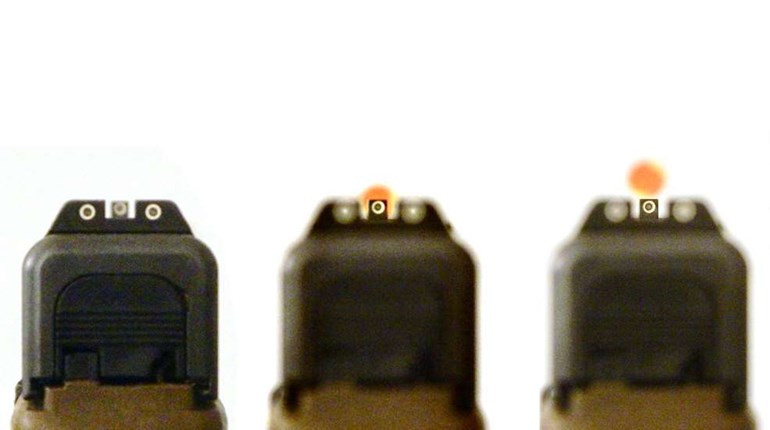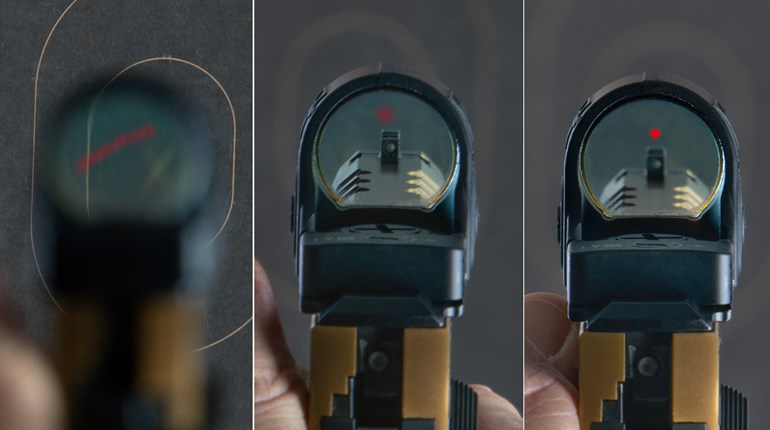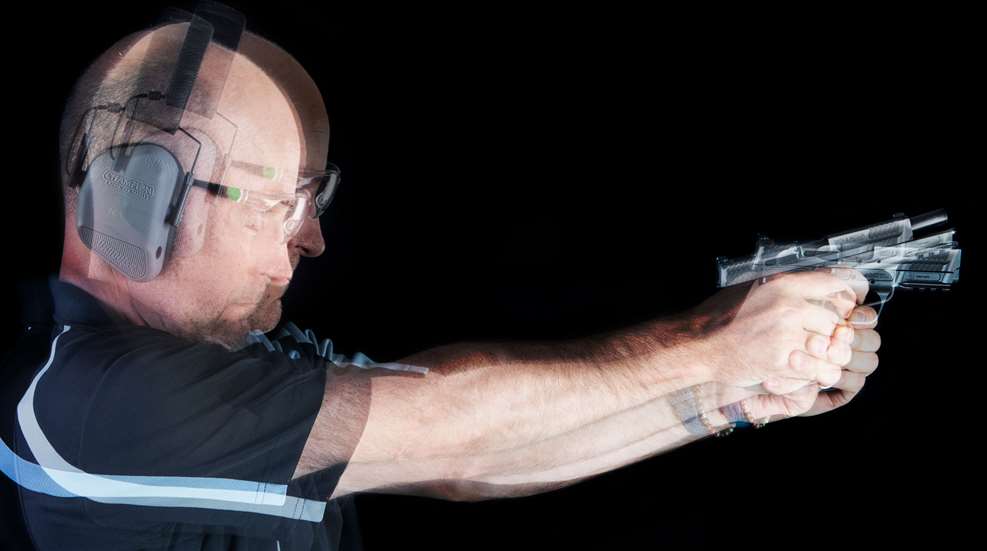
Most shooters believe the shooting process consists of simply aiming and pressing a trigger. What if you were to learn that there might be a high-octane additive to that process? Why is reactive shooting versus predictive shooting such a hot topic among high-performance shooters? How can it contribute to your overall shooting proficiency and further elevate your performance?
In a nutshell, reactive shooting is reacting to your sights or muzzle position, for example, during recoil. Predictive shooting, on the other hand, is knowing where you feel the muzzle is going to be based on “predictive consistent behavior” (a term coined by professional shooter Ben Stoeger).
To demonstrate this concept using a rifle or handgun, next time you’re at the range, set up a target about 15 to 20 yards downrange. Aiming in the upper center mass (A-zone) of that target, press off five consecutive rounds at a comfortable pace to guarantee all your hits exactly where you want them and remember what that shooting process looked like and felt like.
Odds are that you shot those five rounds reactively. In other words, you aligned your sights, fired your rounds, watched the sights return to your point-of-aim (POA) and when they reached their intended resting place, you pressed off another round. The shooting process, broken down into sub-component parts, is to send one round, wait for the sights to return and then wait for alignment verification (visual confirmation) before sending the next round.
Set up that same drill again, and this time don’t wait for any visual confirmation after breaking the shot. Your sight movement should follow a perfect 6- to 12-o’clock trajectory on shot-break recoil. The split second you see the sights move or, more importantly, feel the muzzle move back down toward the 6-o’clock (starting from the 12-o’clock position), start your trigger press before the sights reach your POA. Even though the sights may be in the process of recovering to their start point in realignment with the initial POA, by the time you engage your trigger press, it will all time out perfectly on arrival. All of this, if executed by anticipatory feel, with efficient execution of non-firing mechanics and prefect break timing (firing of the shot) is an example of predictive shooting.
Way back, circa the early 1990s, competitive-shooting pro, the late Mike Voigt, taught his students to “be there early;” that is, know your drawstroke waypoints or transition travel points (to include over and under travel) or recoil recovery (the 6- to 12-o’clock pathway) so very well that you can put yourself there mentally prior to your firearm moving to the anticipated physical position. A good demonstration of what Voigt was teaching can be illustrated with a handgun drawstroke example.
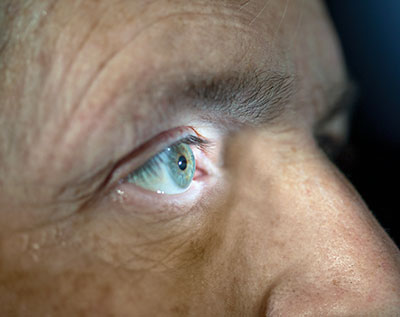
Set up a target at least 10 yards away with a clearly defined A-box. Starting from the holster, draw with a good grip and align your sights with a perfect sight picture superimposed on the A-box. When you have visually confirmed this sight picture, you may then press off a round. Conversely, if, in the process of applying a good grip you feel you’re indexed on target prior to visual confirmation, you can then begin your press because you are already there by feel. At this point, you’ve developed such skill that you can predict a fraction of a second earlier that you will be perfectly aligned during the trigger press at the top of your drawstroke. You have certainly not violated any cardinal safety rules, but you have in fact saved yourself precious hundredths if not tenths of a second by shooting predictively.
Set up a steel target at the 25-yard line. Aim at the steel and, applying a good grip and good hold control, fire five consecutive rounds without missing using predictive shooting. When finished, record your number of hits (hopefully five) and then set it up again. In this next string shoot the exact same drill but this time using reactive shooting. Compare the contrast between the two methods—predictive versus reactive. Once you can clearly see and feel the difference, you will then realize the training value of predictive shooting.
When it comes to either reactive or predictive shooting, the mechanics are physical, whereas the consistency is mental.
Running that drill several consecutive times, you will find that the exercise of shooting predictively further develops your reactive-shooting skills. The reason is that you are assuming muzzle control sooner and you’re never “waiting” to make the gun behave the way you want. Another way to look at predictive shooting is that you are integrating your attention and intention prior to the break, which equates to mental focus combined with visual focus. The combination of this mental/visual focus is what allows you a greater degree of overall control and shot timing.
It does take a bit of getting used to if you’ve never shot predictively. When first experimenting, keep in mind that this is not a speed exercise, but rather a timing exercise. It’s all about when you press off the next round—not how fast. You can shoot predictively at high speeds or at more comfortable speeds, it’s totally up to you to discover and appreciate the difference between the two methods. However, it is recommended to step out past your skills envelope and shoot faster until the wheels fall off in order to find where exactly that edge of your predictive control resides.
In the shooting process, you may observe that you sometimes fall off the 6-to-12 predictable trajectory. However, if you can see it, you can fix it. Recalibrating that 6-to-12 pathway at whatever pace you can handle it allows you to fix any issues with your predictability. In other words, when the wheels fall off, recalibrate your mental and visual focus to track the movement predictively.
Conversely, if your wheels do not fall off and you’re not missing, then you’re not pushing yourself hard enough. All this dark voodoo only works when you intentionally fail, so you may learn from each error. Each lesson learned brings you closer to a greater level of mental understanding, more mechanical skill and better shooting performance.
One of the critical factors of predictive shooting is to remain mentally focused on your intended point-of-impact (POI). For purposes of discussion let’s confirm that POA is very near or at your POI. Rob Leatham teaches that the body cannot go where the mind has not been, and that is the reason he recommends his students “touch the target with your mind.” Leatham’s Jedi mind tricks are what will help guide your muzzle, already in motion, to exactly where you want it by feel. Rob describes his shooting-process work-effort formula as 80 percent feel with a mere 20 percent visual confirmation. It is the 80 percent (feeling) that is the magic fairy dust that makes predictive shooting work.
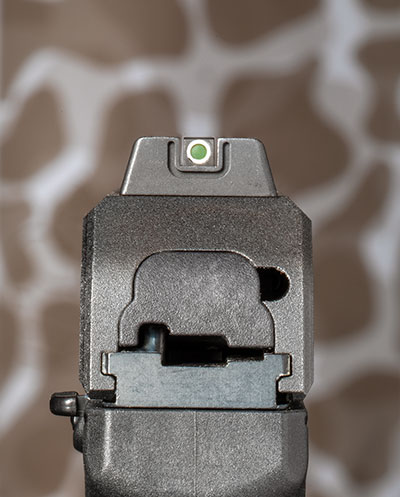
When first learning how to shoot predictively, stay mentally focused on your POA and fire two consecutive rounds. As Leatham would say, “it’s at first a leap of faith” for you to trust where that second round will land by feel. However, as you become more adept and familiar with the concept of “getting there early” (Voigt) it becomes less a matter of blind faith and more a function of “consistent predictive behavior” (Stoeger).
Once you can perform the task, you can start to move faster—beyond your skill level. Pushing past your comfort zone will stretch your skills envelope to where it didn’t reach before. Every drill or exercise you run is an experiment until it starts working for you and is repeatable. When you can repeat it on demand about 80 percent of the time, then you own it. On-demand, repeatable performance is the line of demarcation where familiarity converts to confidence.
Stay mentally and visually focused. If you let up on that mental gas pedal or lose visual focus even for a hundredth of a second, it’s like taking both hands off the steering wheel when you’re driving at 65 mph on the freeway. In other words, fire control is lost if you mentally or visually leave the building when shooting predictively. In lieu of conscious tactile or visual confirmation (verification), mental and visual (target) focus are all that is holding alignment in place (80 percent) prior to breaking the shot at which point your eyes confirm (20 percent).
If you maintain both a mental and visually predictive focus it will allow you to “be there early” (Voigt) so all that remains is the mechanics of sending the round with appropriate timing, a.k.a. a precise trigger press. Staying focused in this manner affords you efficient movement and pinpoint precision placement on your intended landing spot
at speed.
Shooting predictively helps train you to make the gun behave the way you want. The more repeatable you can make it, the more capable you become to pursue the ever-elusive holy grail of shooting consistency. When it comes to either reactive or predictive shooting, the mechanics are physical, whereas the consistency is mental.
One of the critical factors of predictive shooting is to remain mentally focused on your intended point-of-impact.
When shooting a handgun, the slide reciprocates faster than you can physically react. It is the exact reason why Leatham tells his performance-based shooting students “You need to get everything done sooner.” Well, sooner than what? The answer is sooner than where you are in the shooting process, both physically and mentally.
According to Leatham, the shooting process is nothing more than bringing stability to alignment and breaking the shot without disturbing that alignment. The process is simple enough to understand, but not so easy to perform on demand, repeatedly, greater than 80 percent of the time, especially if you are held accountable to achieve more challenging times and
accuracy requirements.
Predictive shooting lends itself to your “being there earlier” in the shooting process. The mental and mechanical processes of predictively bringing stability to alignment afford you discovery of further efficiencies that otherwise elude observation in the reactive shooting modality.
You are invited to experiment with predictive shooting. However, keep in mind that it’s not solely about speed, but rather perfecting timing.
Continuously pushing yourself to expand your abilities and maintain that mental and visual focus throughout the shooting process will expand your overall shooting skillset. With practice and discipline, you will find that predictive shooting can transform your shooting skills, ultimately providing you with a greater and more “behavioral” control and consistency.
Condensing it all down to plain speak, reactive shooting is a matter of reacting to your sights, while predictive shooting is anticipating where your sights will be based on “predictive consistent behavior.”
Whether you are a novice shooter or a seasoned professional, embracing the principles and experimenting with the methodology of predictive shooting can help improve your overall shooting skills.
Improvement does not happen overnight. Consistent practice and successful repetition are key to mastering predictive shooting. Gains are measured in small increments that add up in the long run. Don’t be discouraged by setbacks or slow progress; instead, focus on incremental improvements made over time.
As you continue to develop your predictive shooting ability, you will likely find this shooting method positively affects your reactive-shooting skills. Increased skills translate to improved results in practical application, further developing your confidence and performance.
When comparing reactive and predictive shooting it’s essential to understand that both methodologies have their merits.
Reactive shooting is practically applied for accurate shot placement, while predictive shooting is recommended in training to help you develop a more efficient shooting process by getting there earlier visually and mentally. The key is to exploit the contrast between the two methods and to reap the benefits of practical application.
As you continue to refine your skills in both reactive and predictive shooting, you may find that your growth as a shooter is measurable in both time and accuracy (results). The key is to maintain an open mind about this unconventional training technique, stay mentally and visually focused, and be willing to push past your comfort zone.













